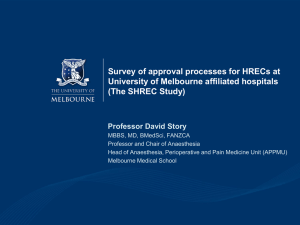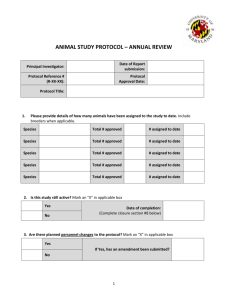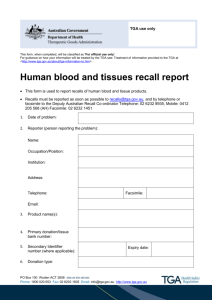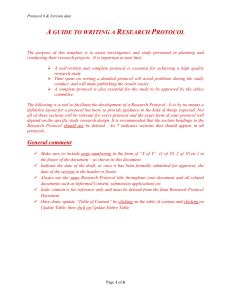HREC ALERT No 1, 18 April 2007 - National Health and Medical
advertisement
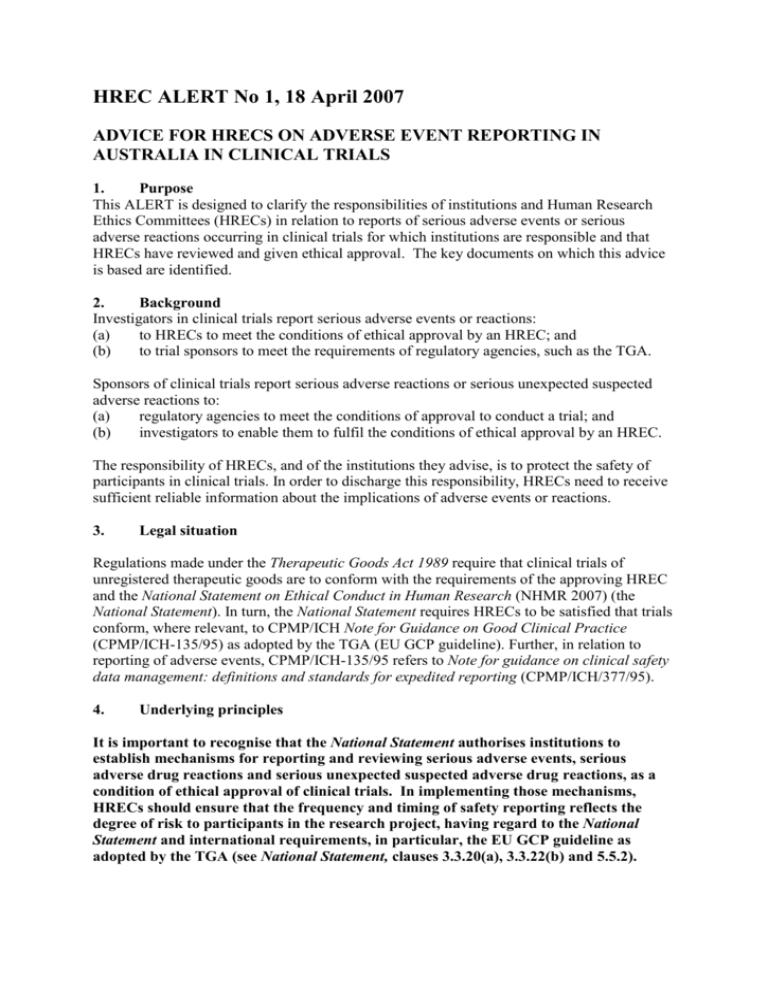
HREC ALERT No 1, 18 April 2007 ADVICE FOR HRECS ON ADVERSE EVENT REPORTING IN AUSTRALIA IN CLINICAL TRIALS 1. Purpose This ALERT is designed to clarify the responsibilities of institutions and Human Research Ethics Committees (HRECs) in relation to reports of serious adverse events or serious adverse reactions occurring in clinical trials for which institutions are responsible and that HRECs have reviewed and given ethical approval. The key documents on which this advice is based are identified. 2. Background Investigators in clinical trials report serious adverse events or reactions: (a) to HRECs to meet the conditions of ethical approval by an HREC; and (b) to trial sponsors to meet the requirements of regulatory agencies, such as the TGA. Sponsors of clinical trials report serious adverse reactions or serious unexpected suspected adverse reactions to: (a) regulatory agencies to meet the conditions of approval to conduct a trial; and (b) investigators to enable them to fulfil the conditions of ethical approval by an HREC. The responsibility of HRECs, and of the institutions they advise, is to protect the safety of participants in clinical trials. In order to discharge this responsibility, HRECs need to receive sufficient reliable information about the implications of adverse events or reactions. 3. Legal situation Regulations made under the Therapeutic Goods Act 1989 require that clinical trials of unregistered therapeutic goods are to conform with the requirements of the approving HREC and the National Statement on Ethical Conduct in Human Research (NHMR 2007) (the National Statement). In turn, the National Statement requires HRECs to be satisfied that trials conform, where relevant, to CPMP/ICH Note for Guidance on Good Clinical Practice (CPMP/ICH-135/95) as adopted by the TGA (EU GCP guideline). Further, in relation to reporting of adverse events, CPMP/ICH-135/95 refers to Note for guidance on clinical safety data management: definitions and standards for expedited reporting (CPMP/ICH/377/95). 4. Underlying principles It is important to recognise that the National Statement authorises institutions to establish mechanisms for reporting and reviewing serious adverse events, serious adverse drug reactions and serious unexpected suspected adverse drug reactions, as a condition of ethical approval of clinical trials. In implementing those mechanisms, HRECs should ensure that the frequency and timing of safety reporting reflects the degree of risk to participants in the research project, having regard to the National Statement and international requirements, in particular, the EU GCP guideline as adopted by the TGA (see National Statement, clauses 3.3.20(a), 3.3.22(b) and 5.5.2). Increasingly, clinical trials conducted in Australia are occurring as part of multi-centre international research trials. Therefore, investigators, sponsors, institutions and HRECs must meet international standards in terms of the approval, monitoring and review of clinical trials conducted at Australian sites, since international standards will be the benchmark for any monitoring or inspections that occur in relation to these trials. 5. Summary of requirements for adverse event reporting in Australia Summary – Adverse Event/Reaction Reporting to Human Research Ethics Committees (HRECs) by Investigators Types of Adverse Event/Reaction Expected adverse reactions Reporting Requirements Provide to HREC if investigator considers the event will impact the research and action is planned as a result (e.g. protocol amendment) Serious Adverse Events (SAEs) at sites under Provide to HREC: HREC approval and for which an Australian If investigator considers the event institution is responsible will impact the research and action is planned as a result (e.g. protocol amendment) OR If reporting to institution is required as per jurisdictional requirements OR If required under conditions of HREC approval Suspected Unexpected Serious Adverse Provide to HREC: Reactions (SUSARs) occurring in Australia With comment by investigator re planned action, or if no action planned Also report to TGA in accordance with pharmacovigilance requirements Annual summary of all SAEs (Australian and All SAEs for the trial with comment international events) for research for which by investigator re action in regard to an Australian institution is responsible trial, or if no action planned More frequent reporting if requested by HREC, e.g. in early phase trial All SUSARs (Australian and international) Listing at least quarterly with comments re planned action or if no action planned Timing to allow EU reports to be utilised 5.1 Expected adverse reactions Reports of expected adverse reactions, both serious and non-serious, as defined in the Investigator’s Brochure, should be provided by investigators to the sponsor and, if applicable, data safety monitoring board (DSMB), as required by the approved trial protocol. 5.2 HRECs do not need to receive reports of expected adverse reactions, unless the sponsor or DSMB consider that there is a need for a change to the Investigator’s Brochure. Serious adverse events or reactions (SAEs) in a clinical trial being conducted at a site for which an Australian institution is responsible An HREC should receive reports of unexpected serious adverse events or reactions (SAEs) that occur at any site to which that HREC’s ethical approval applies and for which the HREC’s institution(s) is/are responsible, if (i) required under the conditions of HREC approval, or (ii) action in relation to the trial will be taken as a result, or (iii) jurisdictional requirements require reporting to institutions. 5.3 Suspected unexpected serious adverse reactions (SUSARs) in a clinical trial being conducted at a site in Australia An HREC should also receive, in relation to any clinical trial it has approved, reports of any serious unexpected suspected adverse reaction (SUSAR) that occurs at any site in Australia. 5.4 TGA notification requirements In line with the EU GCP guideline as adopted by the TGA, investigators and sponsors must expedite notification to the TGA of a SUSAR occurring AT ANY SITE within Australia. TGA will review the situation and decide whether or not a change is required to the Investigator’s Brochure and/or whether a safety warning should be issued. After the TGA report has been issued, sponsors must advise investigators of TGA’s decision and, in turn, investigators must notify HRECs.* TGA does not require that individual overseas reports of SUSARs occurring overseas be provided to the TGA. (See TGA Comment in Note for Guidance on Good Clinical Practice (CPMP/ICH/135/95) at paragraph 5.17 and also TGA Comment in Note for guidance on clinical safety data management: definitions and standards for expedited reporting at paragraph 3 A.1 (p.7). *TGA recommends that HRECs are not only notified that a SUSAR has occurred at a site in Australia, but that HRECs should ultimately receive details of the SUSAR (within 15 calendar days of first knowledge; or, for fatal or life-threatening events, an initial report within 7 calendar days and a follow-up report if necessary within 15 calendar days). 5.5 All other events As a minimum, and as required by the National Statement, annual reporting to HRECs is required and should detail all other adverse events or adverse reactions occurring during research approved by those HRECs at any site for which the institution conducting the research is responsible. 5.6 Significant new information The EU ICH standard on clinical safety data management: definitions and standards for expedited reporting (CPMP/ICH/377/95) has been adopted by the TGA with two important notations. 1. TGA expects sponsors: o to continually monitor the safety of their clinical development programs; and o to advise the TGA (within 72 hours) of any significant safety issue that has arisen from their analysis of overseas reports or from action which has been taken by another country’s regulatory agency. 2. Sponsors should inform any Australian investigator(s) and, through the investigator, the HREC(s) of any information that may be new and may have an impact on the continued ethical acceptability of the trial, or that may indicate the need for amendments to the trial protocol, including altered monitoring of safety. Therefore, HRECs should require that significant new information about a trial is provided to them in a timely manner. Such information might arise from monitoring or analysis of product safety information overseas based on individual safety reports. It is not necessary, nor is it sufficient, for HRECs to receive the individual safety reports themselves without contextual information. 5.7 Investigator’s Brochure The obligation of sponsors to regularly update Investigator Brochures and to provide them via investigators to HRECs, should be a condition of the ethical approval of trials. 6. Key documents The key documents available to HRECs, investigators, sponsors and researchers regarding the conduct and approval of clinical trials in Australia are: 1. The National Statement on Ethical Conduct in Human Research (NHMRC 2007) (National Statement) 2. Note for Guidance on Good Clinical Practice (CPMP/ICH/135/95) - annotated with comments from the Therapeutic Goods Administration (TGA), July 2000 (http://www.tga.gov.au/docs/html/ich13595.htm ) (EU GCP guideline as adopted by the TGA) 3. ICH Note for guidance on clinical safety data management: definitions and standards for expedited reporting (CPMP/ICH/377/95), August 2001 (http://www.tga.gov.au/docs/html/ich37795.htm) 4. Human Research Ethics Committees and the Therapeutic Goods Legislation, June 2001 (http://www.tga.gov.au/docs/pdf/unapproved/hrec.pdf) 5. Access to unapproved therapeutic goods - Clinical trials in Australia (http://www.tga.gov.au/docs/pdf/unapproved/clintrials.pdf) 6. The Australian Clinical Trial Handbook, March 2006 (http://www.tga.gov.au/ct/cthandbook.pdf) 7. Definitions adverse device event adverse drug reaction adverse event (device) clinical trial investigator A clinical sign, symptom or condition that is causally related to the device implantation procedure, the presence of the device, or the performance of the device system. Any noxious and unintended response to an unapproved medicinal product, related to any dose. The phrase “response to an unapproved medicinal product” means that a causal relationship between the product and an adverse event is at least a reasonable possibility, i.e. the relationship cannot be ruled out. (‘Unapproved medicinal product’ here includes approved products used at levels or in ways that are unapproved). Or A noxious and unintended response to a drug that occurs at doses of marketed medical products normally used in humans for prophylaxis, diagnosis or therapy of diseases or for modification of physiological function. Any undesirable clinical occurrence in a subject, whether it is considered to be device-related or not, that includes a clinical sign, symptom or condition and/or an observation of an unintended technical performance or performance outcome of the device. A form of research designed to find out the effects of an intervention, including a treatment or diagnostic procedure. A person responsible for the conduct of the clinical trial at a trial site. In the case of a trial being conducted by a team of individuals at the site, the investigator is the responsible leader of the team and may be called the principal risk serious adverse event suspected unexpected serious adverse reaction sponsor unexpected adverse drug reaction investigator. The function of the magnitude of a harm and the probability that it will occur. Any untoward medical occurrence that: results in death; is life-threatening (NOTE: The term “life-threatening” refers to an event/reaction in which the patient was at risk of death at the time of the event / reaction; it does not refer to an event/reaction which hypothetically might have caused death if it were more severe); requires inpatient hospitalisation or prolongation of existing hospitalisation; results in persistent or significant disability/incapacity; is a congenital anomaly/birth defect; or is a medically important event or reaction. A serious adverse event (see definition above) for which there is some degree of probability that the event is an adverse reaction to the administered drug, and the adverse reaction is unexpected. An individual, company, institution or organisation that takes responsibility for the initiation, management, and/or financing of research. An adverse reaction, the nature or severity of which is not consistent with the applicable scientific information (e.g. Investigator’s Brochure for an unapproved investigational product or Product Information (PI) document or similar for an approved, marketed product).
